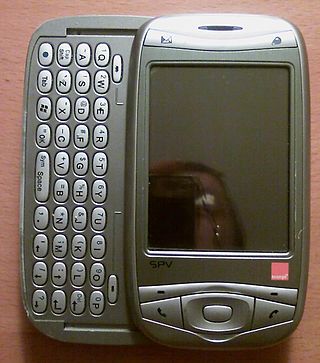
The HTC Wizard is an Internet-enabled Windows Mobile Pocket PC smartphone designed by High Tech Computer Corporation of Taiwan. It has a touchscreen with a left-side slide-out QWERTY keyboard. The Wizard's functions include those of a camera phone and a portable media player in addition to text messaging and multimedia messaging. It also offers Internet services including e-mail, instant messaging, web browsing, and local Wi-Fi connectivity. It is a quad-band GSM phone with GPRS and EDGE. There are variants which differ in the design of the case, the keyboard and the presence of an on-board camera. On AT&T/Cingular, the Wizard was superseded by the HTC TyTN, known as the AT&T/Cingular 8525. On T-Mobile USA, the Wizard was superseded by the HTC P4350, known as the T-Mobile Wing.

The HTC TyTN is an Internet-enabled Windows Mobile Pocket PC PDA designed and marketed by High Tech Computer Corporation of Taiwan. It has a touchscreen with a left-side slide-out QWERTY keyboard. The TyTN's functions include those of a camera phone and a portable media player in addition to text messaging and multimedia messaging. It also offers Internet services such as e-mail, instant messaging, web browsing, and local Wi-Fi connectivity. It is a quad-band GSM phone with GPRS, and EDGE, and a single/dual band UMTS phone with HSDPA. It is a part of the first line of PDAs directly marketed and sold by HTC. On AT&T/Cingular, the TyTN was the successor to the HTC Wizard, known as the Cingular 8125. Also on AT&T, the TyTN was superseded by the HTC TyTN II, known as the AT&T 8925 and the AT&T Tilt.

The HTC TyTN II is an Internet-enabled Windows Mobile Pocket PC smartphone designed and marketed by HTC Corporation of Taiwan. It has a tilting touchscreen with a right-side slide-out QWERTY keyboard. The TyTN II's functions include those of a camera phone and a portable media player in addition to text messaging and multimedia messaging. It also offers Internet services including e-mail, instant messaging, web browsing, and local Wi-Fi connectivity. It is a quad-band GSM phone with GPRS, EDGE, UMTS, HSDPA, and HSUPA.

The HTC Touch Pro is a smart phone from the Touch series of Internet-enabled Windows Mobile Pocket PC smartphones designed and marketed by HTC Corporation of Taiwan. It is an enhanced version of the HTC Touch Diamond with the addition of a left-side slide-out QWERTY keyboard, a microSD card slot, and a camera flash. The Touch Pro smartphone's functions include those of a camera phone and a portable media player in addition to text messaging and multimedia messaging. It also offers Internet services including e-mail, instant messaging, web browsing, and local Wi-Fi connectivity. Depending on its market, it is a quad-band GSM or quad-band UMTS phone with GPRS, EDGE, UMTS, HSDPA, and HSUPA or a tri-band CDMA phone with 1xEV-DO Rev A. All versions feature TouchFLO 3D — a new enhanced version of the TouchFLO interface, unique only to the latest Touch series. In March 2009, HTC announced a new version, the Touch Pro2 which has a larger screen (3.6") and a redesigned slide out QWERTY keyboard with spaces between the keys.

The HTC Dream is a smartphone developed by HTC. First released in October 2008 for $179 with a 2-year contract to T-Mobile, the Dream was the first commercially released device to use the Linux-based Android operating system, which was purchased and further developed by Google and the Open Handset Alliance to create an open competitor to other major smartphone platforms of the time, such as Symbian, BlackBerry OS, and iPhone OS. The operating system offers a customizable graphical user interface, integration with Google services such as Gmail, a notification system that shows a list of recent messages pushed from apps, and Android Market for downloading additional apps.

The HTC Touch Pro2 is a slate smartphone, part of the Touch series of Internet-enabled, Windows Mobile, Pocket PC smartphones designed and marketed by HTC Corporation of Taiwan. It is an enhanced version of the HTC Touch Pro with a left-side slide-out QWERTY keyboard, with tilting screen. The Touch Pro2 smartphone's functions include those of a camera phone and a portable media player in addition to text messaging and multimedia messaging. It also offers Internet services including e-mail, instant messaging, web browsing, and local Wi-Fi connectivity. Visual voicemail is not a standard feature for the Touch Pro2, unlike its predecessor the Touch Pro. The Verizon Wireless version does include a visual voicemail application, however. All versions feature TouchFLO 3D — a new enhanced version of the TouchFLO interface, unique only to the latest Touch series. The latest update renamed TouchFLO 3D to SenseUI, to match HTC's Android offering. The Touch Pro2 — along with its sister model, the Touch Diamond2 — were unveiled on February 16, 2009 in Barcelona, Spain at the Mobile World Congress 2009. Specific enhancements over the original Touch Pro include:

HTC Magic is an Android smartphone designed and manufactured by HTC. It is HTC's second Android phone after HTC Dream, HTC's first touch-only flagship Android device and the second Android phone commercially released, as well as the first Android phone without a keyboard.
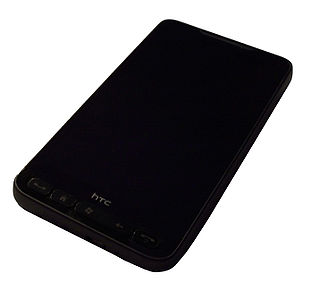
The HTC HD2, is a smartphone in the HTC Touch family designed and manufactured by HTC. The HD2 natively runs the Windows Mobile 6.5 operating system, and was released in Europe in November 2009, in Hong Kong in December 2009, and in other regions including North America in March 2010. The phone is the successor to the HTC Touch HD, and is succeeded by the HTC HD7.

The HTC Evo 4G is a smartphone developed by HTC Corporation and marketed as Sprint's flagship Android smartphone, running on its WiMAX network. The smartphone was launched on June 4, 2010. It was the first 4G enabled smartphone released in the United States.

The Samsung Galaxy S is a touchscreen-enabled, slate-format Android smartphone designed, developed, and marketed by Samsung Electronics; it is the first smartphone of the Samsung Galaxy S series. It is the first device of the third Android smartphone series produced by Samsung. It was announced to the press in March 2010 and released for sale in June 2010. Due to shortage of Super AMOLED displays, Samsung released a successor to the device called S scLCD or SL and ceased production of the original I9000 model.

The HTC Wildfire is a smartphone developed by the HTC Corporation, that was announced on 17 May 2010 and released in Europe in June of the same year. It is powered by a 528 MHz Qualcomm processor and runs the Android operating system, version 2.2. It includes a TFT LCD capacitive touchscreen and a 5-megapixel camera. It has been described as a "Mini HTC Desire", and is perceived to be a follow-up model to the previous year's Tattoo.

The T-Mobile myTouch 3G Slide is a smartphone designed and manufactured by HTC, and sold by T-Mobile USA. HTC's name for the device during development was Espresso. The 3G Slide was unveiled by T-Mobile USA on May 4, 2010, pre-orders began May 23, 2010 and the device went on sale June 2, 2010.
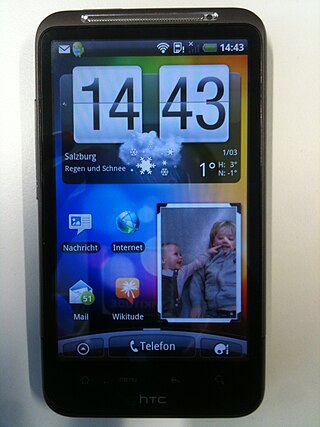
The HTC Desire HD is an Android smartphone by HTC Corporation. It was unveiled at a press event in London hosted by HTC on September 15, 2010, and was made available for sale in October in Europe and in January 2011 in Canada. The Desire was HTC's fourth flagship Android device until the release of their new line of flagship model, the HTC Sensation.
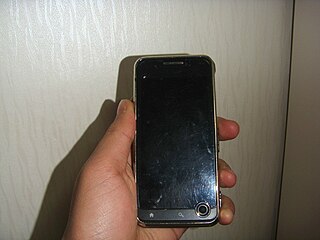
The LG Optimus Q, also known as the LG LU2300 is a high-end smartphone manufactured by LG Electronics for the South Korean market. It is LG's first high-end handset to run Google's Android operating system.
The HTC Evo Shift 4G is a smartphone developed by HTC Corporation and marketed as the concurrent/sequel to Sprint's flagship Android smartphone, running on its 4G WiMAX network. The smartphone launched on January 9, 2011.

The Sony Ericsson Xperia pro is an Android smartphone from Sony Ericsson which was launched in October 2011. The Xperia Pro has a 3.7-inch (94 mm) capacitive touch-screen, slider keyboard, smart phone with mobile BRAVIA engine which optimises the picture and runs at a resolution of 854×480 pixels, a 1 GHz Snapdragon processor, an 8.1 mega-pixel camera, a dedicated Two-step camera key, USB host port, HDMI-out, 512 MB of onboard RAM, and an 8 GB microSD card. The Sony Ericsson Xperia Pro is available in black, silver, or red.

The HTC One S is a premium smartphone designed and manufactured by HTC as part of the HTC One series which has Beats Audio and runs the Android 4.0 "Ice Cream Sandwich" mobile operating system with HTC Sense. Announced by HTC on 26 February 2012, the HTC One S was scheduled for official release on 2 April 2012. The first phones were sold on March 30. In the United States, the One S is carried by T-Mobile and Solavei.
The HTC Desire 601 is an Android smartphone designed and manufactured by HTC. The Desire 601 is a mid-range device carrying design traits from the HTC One and One Mini, utilizing a dual-core processor, 4.5-inch qHD display, and offering LTE support.
HTC Desire is a series of Android smartphones designed and manufactured by HTC. All products in the Desire series were designed to be affordable, touchscreen-based and slate-sized, and run the Android mobile operating system with the HTC Sense graphical user interface except for the HTC Desire 616, HTC Desire 516. HTC Desire 310 and HTC Desire 210, all of which feature a mixed user interface of HTC Sense and the Android Open Source Project.
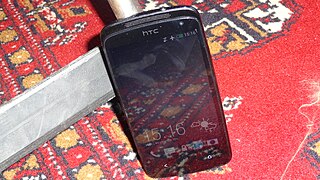
The HTC Desire 500 is a low-mid-range Android smartphone released by HTC in 2013. On 23 July 2013, HTC Desire 500 was announced in Taiwan. On 7 August 2013, the device was unveiled for the European market.




















